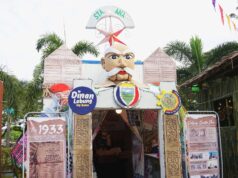CITY OF SAN FERNANDO —The national fisherfolk alliance Pamalakaya has filed a diplomatic protest at the Japanese embassy in Manila over the reported tuna poaching by Japanese firms in Aurora province.
Sen. Edgardo Angara, a native of Aurora , found the move of Pamalakaya “unnecessary.”
“We can solve this ourselves,” the senator said in a phone interview on Wednesday.
Angara mentioned the alleged encroachments by Japanese, Korean and Taiwanese companies in his speech at the launch of the Aurora province extension office at the Clark Freeport last Dec. 12.
Pamalakaya’s three-page protest note, sent by fax last Tuesday, was signed by Fernando Hicap and Salvador France, national chair and vice chair for Luzon , respectively.
Addressed to Japanese Ambassador Makoto Katsura, it said that the “national leadership and mass membership of Pamalakaya in the name of 1.8 million small Filipino fisherfolk and close to 90 million Filipino people, strongly condemned this poaching frenzy of Japanese corporate factory ships inside the Philippine waters.”
Hicap and France said they view the illegal fishing as “gross violations of our national sovereignty and patrimony.
Angara had said the foreign fishing vessels are seen by Aurora fisherfolk during the January-July tuna season. At any time, eight ships, some with canneries, haul fishes in the waters of northern Aurora .
Located in eastern Central Luzon, Aurora faces the Philippine Sea that empties into the Pacific Ocean .
The senator and his sister, Gov. Bellaflor Angara-Castillo, have asked the Philippine Coast Guard to establish a station in northern Aurora and assign patrol boats there.
Angara has also asked the Port of Valencia , one of the biggest port developers in the world, to come in February 2009 to explore a plan to help develop a port for the 500-hectare Aurora Special Economic Zone in Casiguran town. Investors from Basque , Spain have been invited to start sea farming ventures in the 300-hectare Aurora Mariculture Park started in Casiguran three years ago.
Fishermen had reported seeing long-line fishing gears that are used in the capture of tuna, blue marlin and other high-value fishes, according to provincial fishery officer Victoriano San Pedro.
Hicap and France told Katsura that a single Japanese tuna factory ship could create damage to Philippine tuna resources.
“A 3,000-ton tuna factory ship, accompanied by support fishing fleets, can catch as much as 150 metric tons (MT) of tuna on a 24-hour operation basis. By industry standard, a single factory ship could harvest 50,000 MT per year,” they said.
They estimated that the eight fishing vessels seen in northern Aurora could haul as much as 216,000 MT in six months or earn a total of US$1.274 billion for the same period.
“Honorable Ambassador, the situation is expected to get worse with the Senate ratification of the controversial Japan-Philippines Economic Partnership Agreement (Jpepa) last October because under the one-sided agreement, the Philippine government fully recognizes the entry of Japanese factory ships into the Philippine waters at the detriment and expense of our small tuna fishermen and the already fragile marine environment,” the Pamalakaya leaders said.
According to the group, Japan consumes 630,000 tons of tuna yearly. Japan has tapped other sources like the Philippines, given its shrinking catch.
Some 180,000 Filipino fishermen and workers will be affected by the depletion of tuna stocks or closure of local tuna-importing firms, they told Katsura.
Hicap and France described the situation to be “very, very alarming.”
“The Philippine waters which is part of the country’s national territory has become an open city for foreign fishing plunderers led by Japanese tuna fishing interests yet the Japanese government is not making any decisive action to stop this “gang rape” of Philippine tuna stocks” by Japanese tuna factory ships,” they added.
Hicap and France expected that their diplomatic protest would reach the Japanese Diet, expecting also “swift, concrete and reasonable resolution and dispatch” from the lawmaking body.
Sen. Edgardo Angara, a native of Aurora , found the move of Pamalakaya “unnecessary.”
“We can solve this ourselves,” the senator said in a phone interview on Wednesday.
Angara mentioned the alleged encroachments by Japanese, Korean and Taiwanese companies in his speech at the launch of the Aurora province extension office at the Clark Freeport last Dec. 12.
Pamalakaya’s three-page protest note, sent by fax last Tuesday, was signed by Fernando Hicap and Salvador France, national chair and vice chair for Luzon , respectively.
Addressed to Japanese Ambassador Makoto Katsura, it said that the “national leadership and mass membership of Pamalakaya in the name of 1.8 million small Filipino fisherfolk and close to 90 million Filipino people, strongly condemned this poaching frenzy of Japanese corporate factory ships inside the Philippine waters.”
Hicap and France said they view the illegal fishing as “gross violations of our national sovereignty and patrimony.
Angara had said the foreign fishing vessels are seen by Aurora fisherfolk during the January-July tuna season. At any time, eight ships, some with canneries, haul fishes in the waters of northern Aurora .
Located in eastern Central Luzon, Aurora faces the Philippine Sea that empties into the Pacific Ocean .
The senator and his sister, Gov. Bellaflor Angara-Castillo, have asked the Philippine Coast Guard to establish a station in northern Aurora and assign patrol boats there.
Angara has also asked the Port of Valencia , one of the biggest port developers in the world, to come in February 2009 to explore a plan to help develop a port for the 500-hectare Aurora Special Economic Zone in Casiguran town. Investors from Basque , Spain have been invited to start sea farming ventures in the 300-hectare Aurora Mariculture Park started in Casiguran three years ago.
Fishermen had reported seeing long-line fishing gears that are used in the capture of tuna, blue marlin and other high-value fishes, according to provincial fishery officer Victoriano San Pedro.
Hicap and France told Katsura that a single Japanese tuna factory ship could create damage to Philippine tuna resources.
“A 3,000-ton tuna factory ship, accompanied by support fishing fleets, can catch as much as 150 metric tons (MT) of tuna on a 24-hour operation basis. By industry standard, a single factory ship could harvest 50,000 MT per year,” they said.
They estimated that the eight fishing vessels seen in northern Aurora could haul as much as 216,000 MT in six months or earn a total of US$1.274 billion for the same period.
“Honorable Ambassador, the situation is expected to get worse with the Senate ratification of the controversial Japan-Philippines Economic Partnership Agreement (Jpepa) last October because under the one-sided agreement, the Philippine government fully recognizes the entry of Japanese factory ships into the Philippine waters at the detriment and expense of our small tuna fishermen and the already fragile marine environment,” the Pamalakaya leaders said.
According to the group, Japan consumes 630,000 tons of tuna yearly. Japan has tapped other sources like the Philippines, given its shrinking catch.
Some 180,000 Filipino fishermen and workers will be affected by the depletion of tuna stocks or closure of local tuna-importing firms, they told Katsura.
Hicap and France described the situation to be “very, very alarming.”
“The Philippine waters which is part of the country’s national territory has become an open city for foreign fishing plunderers led by Japanese tuna fishing interests yet the Japanese government is not making any decisive action to stop this “gang rape” of Philippine tuna stocks” by Japanese tuna factory ships,” they added.
Hicap and France expected that their diplomatic protest would reach the Japanese Diet, expecting also “swift, concrete and reasonable resolution and dispatch” from the lawmaking body.




